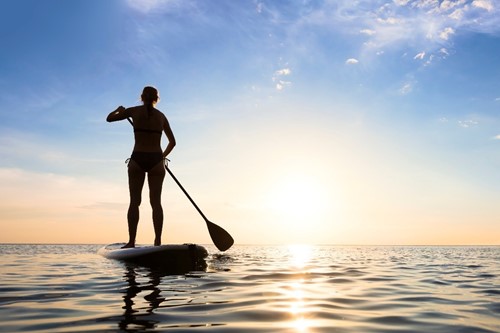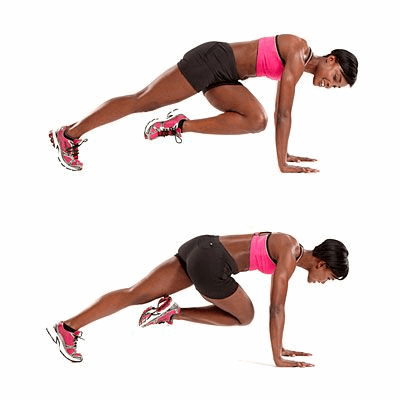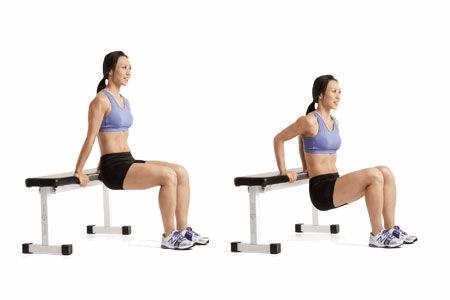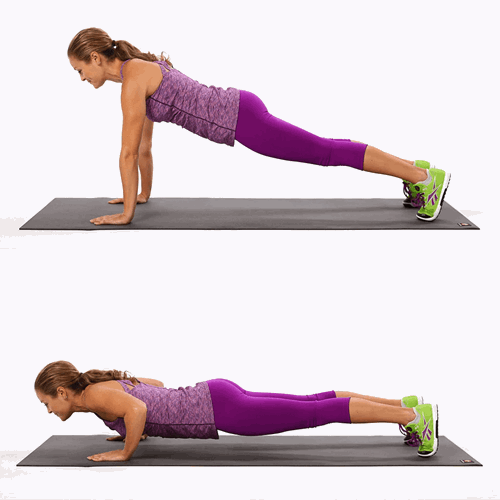
The appeal of paddleboarding is easy to see – it’s accessible to everyone, reduces stress, and allows you to really be at one with nature. Although, compared with other water sports, stand-up paddleboarding is easy to get the hang of, but if your muscles aren’t used to being worked in this way you’ll be tiring out pretty quickly!
To make sure you can enjoy the tranquillity of the water on your paddle board without feeling the strain of your aching muscles, here are 5 exercises that’ll help you become an SUP master.
1. Mountain climbers – Core
In order to paddle board, balance is crucial – you won’t be going very far if you can’t stay on the board! As we all know, the key to good balance is a strong core, so the first exercise on our list targets your abdominal muscles to achieve exactly that.
Mountain climbers are one of the best exercises to target your core as well as your cardio fitness:
- Get into a push-up position with your arms straight and the balls of your feet on the floor.
- Lift your left knee straight up towards your left arm and then back down.
- Repeat with your right knee and right arm.
- Once you’ve got the hang of this, speed up each rep and keep going for 30 seconds.
- Allow a 30-second break and repeat the process twice more.
Your abs should be aching after that, but if you think you can handle it, there are plenty of ab exercises to take the work out one step further – the plank, sit-ups and crunches to name just a few!

2. Tricep dips – Triceps
Once you’ve got your balance mastered, paddling is the next important thing and (as you could probably guess) your arms are instrumental in this. The triceps are often overlooked but they play one of the biggest roles in the arm in pulling the paddle through the water. Strengthening them will therefore mean you notice a big difference in a) your paddle power and b) how long you can paddle for before getting tired.
Tricep dips – as the name suggests - are great for your triceps and are very straightforward to do. All you’ll need is a bench or a chair but failing that you can always use the floor!
- Start sat down on the bench or floor with your knees bent and feet on the floor. Place your hands behind you, directly under the shoulders, and lift your hips to a hover.
- From this position, start to dip by bending your elbows.
- Try and lower your body as slowly as you can – this means your muscles will be under tension for as much time as possible.
- Pause at the bottom for a second or two, then powerfully press back up.
- Once at the top, don’t lock your elbows to ensure your triceps are working as hard as they can.
- Do 15-20 reps per set and do two to three sets.


3. Floor lat press – Middle back
Your middle back muscles (latissimus dorsi) are also a key muscle group that’s activated when you paddle board. Building a stronger back will not only aid your SUP technique, it will also give your core a helping hand in keeping you balanced and upright.
When it comes to building back muscle, most people’s go-to is a pull-up or a pull-down machine, but not everyone has gym equipment at their disposal. That’s why our next move – the floor lat press - needs nothing more than the floor:
- Lie down with your back on the floor, rest your upper arms next to your upper body and lift your forearms to a 90-degree angle.
- Angle your legs at 90-degrees and place them on the floor or in the air for a tougher exercise.
- Push your upper arms down to the ground and guide the body up.
- Make sure it’s your arms pushing you up rather than your abs.
- Slowly lower yourself back down.
- Do 15-20 reps per set and do two to three sets.
4. Lunges – Thighs and glutes
To keep the right posture on your paddle board you’ll work a range of muscles in your legs. The hardest working of these muscles are your quadriceps (front thigh), hamstrings (back thigh) and glutes, which are engaged to keep you balanced and each time you bend your knees to paddle.
Lunges are the ideal exercise to prepare you to SUP – they target all the above muscles and the motion means you’re also practising balance. As with the other exercises in this list, you don’t need any equipment but once you perfect the technique, hold some dumbbells in each hand to really push your legs to their limits! Here are the basics:
- Keep your upper body straight, with your shoulders back and relaxed.
- Step forward with one leg, lowering your hips until both knees are bent at a 90-degree angle.
- Make sure your front knee is directly above your ankle and that your other knee doesn’t touch the floor.
- Push back up to your starting position, keeping the weight in your heels.
- Keep your abs engaged the whole time.
- Do 12 reps on each side and repeat 3 times.
5. Push-ups – Shoulders, chest and arms
The motion of putting your paddle into and through the water to move your paddle board along relies heavily on your shoulders, meaning they’re likely to fatigue the quickest. Be sure not to neglect them in your cross-training session and you’ll find yourself able to paddle for longer.
The push-up needs no introduction. At one point or another, every muscle group is engaged during this exercise, but the shoulders, chest and arms are being particularly challenged which are all muscles engaged when you SUP… how convenient! Virtually everyone is familiar with the motion of a push-up but mastering the correct form is crucial:
- Lie down on your front and place your hands at a distance slightly wider than shoulder-width apart.
- Set up your feet in a way that’s comfortable for you. That might be shoulder-width apart or with your feet together.
- Straighten your arms so that they’re now holding your body weight and your body is in a straight line – this is your starting position.
- Steadily lower yourself until your elbows are at a 90-degree angle or smaller depending on your ability.
- Explode back up until you’re back in the same position.
- Keep your abs and glutes tense the whole time.
- Do 3 sets of 12 reps.

Practise these exercises regularly and you’ll notice a massive difference on the paddle board. Hitting the water worry-free with paddle board insurance is also a great way to free up your mind to concentrate on mastering your technique.
What exercises do you recommend to turn you into an SUP master? Let us know on Twitter or Facebook!

